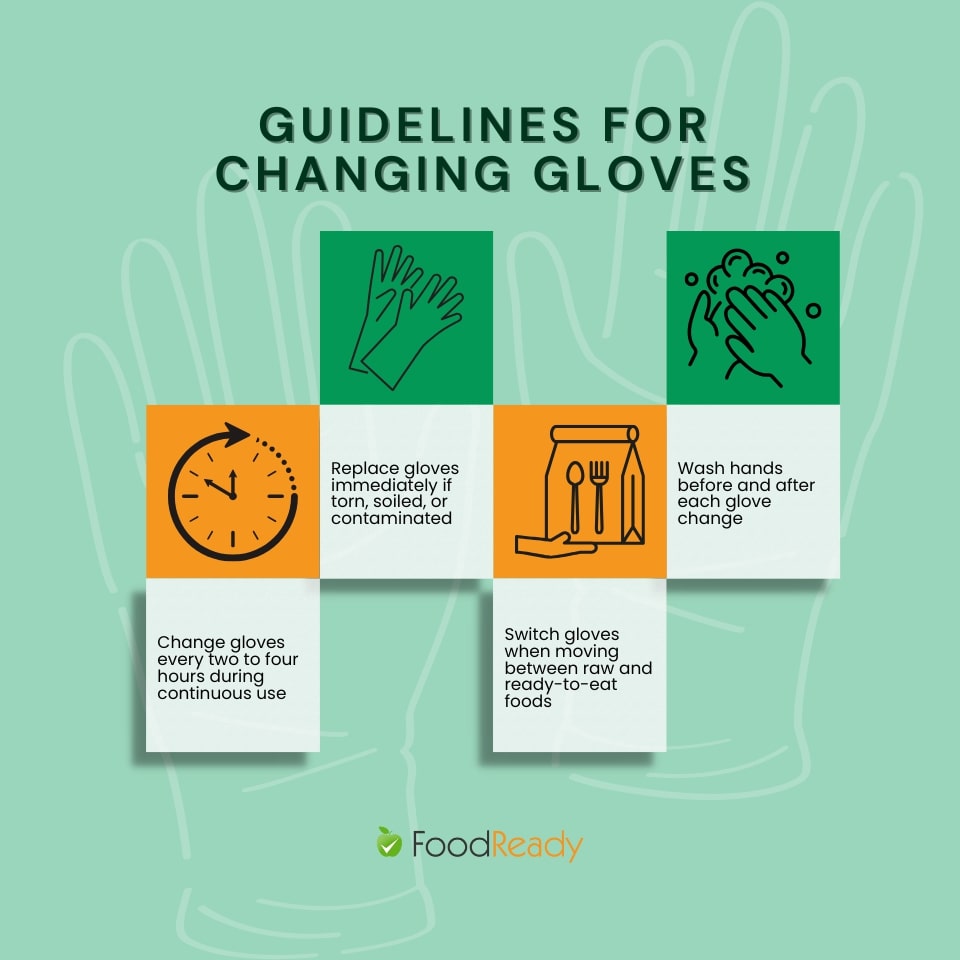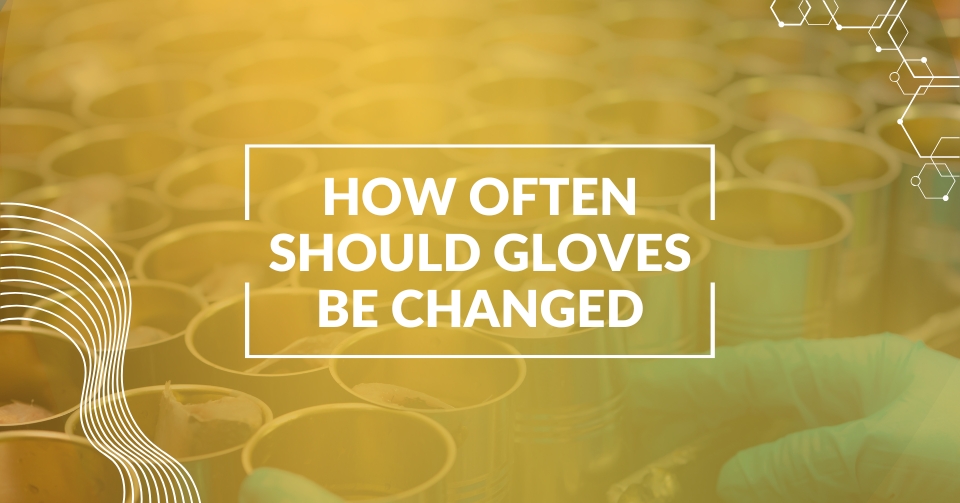Wearing gloves is vital in preventing food contamination and limiting the spread of pathogens in food service settings. Gloves act as a protective barrier between hands and food, significantly lowering the risk of foodborne illnesses caused by harmful bacteria. In addition to protecting food, gloves shield skin from direct contact with potentially hazardous substances.
Disposable gloves are essential for reducing cross-contamination and exposure to infectious material. They’re commonly used in kitchens where cleanliness and sanitation are non-negotiable. However, using gloves correctly and changing them at the appropriate times is essential for maintaining hygiene and ensuring safety.
When to Wear Gloves
Gloves should be worn when preparing or handling food, particularly raw meat. This practice helps prevent the transfer of bacteria from hands to food. Tasks involving high-risk foods, such as slicing vegetables or assembling salads, require gloves to reduce contamination.
Using gloves limits direct contact between hands and food, significantly decreasing the risk of introducing pathogens. Proper glove usage is crucial when working with foods prone to cross-contact with allergens. Employees should always wash their hands before putting on gloves to ensure cleanliness.
Glove Changing Guidelines
- Change gloves every two to four hours during continuous use
- Replace gloves immediately if torn, soiled, or contaminated
- Switch gloves when moving between raw and ready-to-eat foods
- Wash hands before and after each glove change

For instance, workers should change gloves after handling raw meat before touching salad greens, which prevents harmful bacteria from spreading. Gloves must also be changed when switching between tasks, such as moving from food prep to cleaning, or after touching contaminated surfaces or non-intact skin. Avoid touching personal items like phones while wearing gloves.
Kitchen Staff and Gloves
Kitchen workers should wear gloves during food preparation, especially when handling ready-to-eat or raw foods. Workers must change gloves after breaks and any time a task is interrupted. Proper handwashing is essential before putting on new gloves and after removing them.
Choosing the right glove size is also critical, as poorly fitting gloves are more likely to tear and compromise food safety. Gloves should be worn when handling food and when touching equipment or utensils that come into contact with food. Workers should also use cut-resistant gloves to prevent injuries from tasks involving knives or blades.
Single-Use Gloves
Single-use gloves are designed for one-time use per task. They should never be reused, especially when switching between food types. Improper glove reuse can lead to severe contamination and increase the risk of foodborne illness.
These gloves must be disposed of immediately after use in appropriate waste containers. Food handlers must wash their hands before and after using single-use gloves to maintain sanitary conditions. This ensures a fresh start with each glove change and reduces the possibility of transferring bacteria.
Changing Gloves to Prevent Contamination
- Change gloves every two hours or sooner, especially when switching tasks
- Replace gloves immediately after handling raw meat
- Always use fresh gloves for ready-to-eat foods
- Follow FDA recommendations for glove change intervals
Frequent glove changes are one of the most effective ways to prevent contamination. Following these best practices helps ensure food safety and reduces the risk of foodborne illness.
This principle holds not only in kitchens but also in sterile lab environments. In my experience working in a sterile lab, strict glove protocols were non-negotiable. Micropropagators had to wear gloves when working within the sterile laminar flow hood. Gloves had to be changed under three particular conditions:
- Immediately after stepping away from the sterile hood
- At the first sign of a tear or puncture, no matter how small
- After returning from a break or leaving the work area for any reason
These measures preserved the sterile field and prevented cross-contamination. The level of attention to glove hygiene reinforced a culture of vigilance, precision, and responsibility, values that directly translate to food safety practices. In a laboratory or food service setting, routine glove changes help maintain integrity and protect people and products.
Proper Glove Removal and Disposal
- Peel the gloves off from the wrist and turn them inside out to contain contaminants.
- Dispose of used gloves in designated waste containers
- Wash hands immediately after glove removal
- Reinforce hygiene practices through consistent glove removal protocols
This process helps minimize the spread of germs and ensures a safe environment for workers and consumers alike.
Benefits of Wearing Gloves
- Reduces the risk of foodborne illnesses caused by bacteria
- Acts as a physical barrier between hands and food
- Maintains sanitary conditions in kitchens and healthcare facilities
- Prevents the spread of infectious materials during food prep or medical care
Common Mistakes to Avoid
Many people make errors in glove use that can compromise food safety. One common mistake is reusing gloves across multiple tasks, which can lead to serious cross-contamination. Another frequent issue is skipping handwashing before or after glove use. Both practices increase the risk of spreading pathogens.
Additionally, workers often forget to change gloves when switching between different food types or after touching unsanitary surfaces. Improper disposal of used gloves can also lead to contamination. These mistakes can all be avoided through regular training and oversight.
Best Practices for Glove Use
- Wash and dry your hands before putting on gloves
- Ensure gloves fit properly and cover the wrist
- Avoid touching non-food contact surfaces while gloved
- Change gloves if they’re torn, dirty, or compromised
- Inspect gloves regularly during use
- Consider double-gloving for allergen or biohazard tasks
- Train staff on glove safety and change protocols
- Follow proper removal and disposal procedures
Conclusion
Changing gloves regularly is essential for protecting both food and public health. Gloves help prevent contamination, but only when used correctly. Frequent changes, good hand hygiene, and adherence to safety protocols form the foundation of safe food handling. By following these guidelines, food handlers and healthcare workers can help ensure a secure, sanitary environment for everyone.
FAQs
Gloves should be changed every 2–4 hours during continuous use, or sooner if they become torn, contaminated, or after switching tasks.
No. Single-use gloves must be discarded after each task. Reusing them increases the risk of cross-contamination and foodborne illness.
Yes. You must wash your hands before wearing gloves and after removing them to maintain proper hygiene.
Change gloves when moving from raw to ready-to-eat foods, after touching contaminated surfaces, or after taking a break.








